A shock of dark hair falls across Petr Ginz's pale forehead as he hunches over a notebook, his serious blue eyes intent on the painting emerging from his talented hands. He applies his brush to the broken block of watercolor paint and then embellishes the image of Ka-Du, a terrible beast with glowing red eyes. The gigantic monster lurches after his human prey with implacable ferocity, leaving in his wake wails of grief and despair.
The works of Petr's favorite author, science fiction writer Jules Verne, didn't provide inspiration for Ka-Du. This 14-year-old knows that he's being stalked by a real-life monster, one that's already captured many of his friends and family. A black cloud hovers over him and the future seems bleak, but still Petr Ginz paints and dreams.
Petr (pronounced Pay-ter) wrote the tale of Ka-Du while imprisoned for two years in a Nazi concentration camp during World War II. The story of a dinosaurlike monster that stalks the Belgian Congo represents an allegory for the tyranny inflicted on millions of Jews during Hitler's regime. Yet, even while incarcerated in Terezin camp in Czechoslovakia, Petr defied his captors and refused to succumb to despair. Instead, this extraordinary Prague schoolboy pursued his love of learning in secret and created art, fiction, and poetry that live on today.
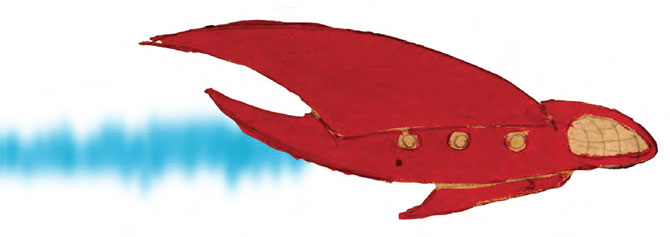 Illustration: Petr Ginz/From the Private Collection of Chava Pressburger
Illustration: Petr Ginz/From the Private Collection of Chava PressburgerPetr's triumphant story now inspires audiences worldwide through a 70-minute documentary, The Last Flight of Petr Ginz, which hauntingly depicts the clash of a child's innocence with the atrocities of the adult world. Co-directed by a University of Iowa alumnus, the film blends Petr's own drawings and archival film images from the Nazi era with modern animation and interviews with Holocaust survivors.
Florida-based filmmaker Churchill Roberts, 72PhD, is accustomed to tackling tough projects about human rights and social justice, but he found himself particularly moved by the story of this mischievous boy with the wide smile who managed to persevere in the midst of such horror. As Roberts says, "The film juxtaposes what is best and what is worst about humanity."
Often, during the three-year process of making the film, a remarkable series of coincidences convinced Roberts that he was meant to share Petr's story with the world. Vital financial backing came from a businessman and charitable foundation trustee who happened to receive a fundraising letter shortly after he'd visited the Terezin concentration camp memorial. And, at a New York fundraising event for the documentary, Roberts met a United Nations staffer whose connections led to the organization's endorsement and support of the film.
But the beginnings of the project started several years earlier—with another tragedy that shocked the world.
Under Petr's clever, quick hands, a red rocket ship takes shape on the paper. The small craft coasts above the moon's monochromatic terrain, pauses to look back at the globe of the Earth decorating the dark sky, and then leaps eagerly towards the beckoning stars.
Decades before humans ever voyaged into space or set foot on the moon, Petr Ginz fantasized about the mysteries of the universe. So, it seemed a fitting twist of fate that his art would finally make it to the stars. In 2003, when Israeli astronaut Ilan Ramon prepared for his mission aboard the U.S. space shuttle, he wanted to take items commemorating the Holocaust. He chose one of Petr's sketches of a lunar landscape. After 16 days in orbit, the space shuttle Columbia began its voyage home—one that went catastrophically wrong when the vessel exploded, killing Ramon and six American astronauts.
The disaster occurred on what would have been Petr's 75th birthday. Yet, in one of those strange turn of events that Roberts later noticed, it helped bring Petr's work to a wider audience.
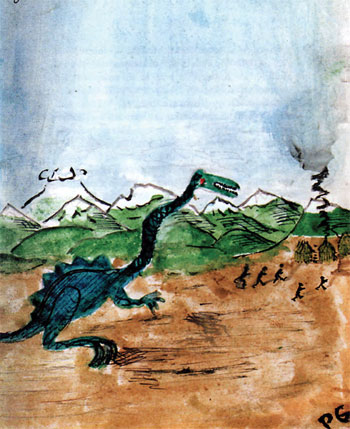 Illustration: Petr Ginz/From the Private Collection of Chava Pressburger
Through novels, articles, and
artwork like the allegorical
monster Ka-Du, schoolboy
Petr Ginz wielded creativity,
intelligence, and resilience to
protest the tyranny of Nazi
Germany.
Illustration: Petr Ginz/From the Private Collection of Chava Pressburger
Through novels, articles, and
artwork like the allegorical
monster Ka-Du, schoolboy
Petr Ginz wielded creativity,
intelligence, and resilience to
protest the tyranny of Nazi
Germany.Hearing Petr's name mentioned during an evening TV news story about the shuttle tragedy, a man in Prague recalled some exercise books he'd discovered in the attic of an old house and inexplicably held onto for years—books containing Petr's words and images. He contacted the Yad Veshem Holocaust museum in Israel with an offer to sell the diaries.
The books didn't look special. Handmade from cheap, repurposed paper, they were flimsy and fragile. Inside their faded pages, though, Petr provided eyewitness accounts of one of the worst times in human history, from the early days of the Nazi regime right up to the height of its evil.
The diaries eventually made their way to Petr's sister, Eva, who went on to edit and publish her brother's accounts of life in Prague and a concentration camp. The Diary of Petr Ginz, 1941-42 attracted glowing reviews and inevitable comparisons to the work of Anne Frank. Unlike Anne Frank, though, Petr rarely expressed his feelings or emotions; his entries were often brief and matter-of-fact, with notes about the weather, his homework, and visits to his grandmother. Alongside such daily affairs, he recorded the impact of the war and the ways in which the Nazis began to crack down on Jews.
Petr's diary begins on Sept. 19, 1941, with a description and drawing of "sheriff's stars"—the humiliating yellow badges depicting the Star of David and the word "Jude" that Jews were required to wear in public. "When I went to school, I counted 69 'sheriffs,' he wrote. "Mummy counted more than a hundred of them."
When Sandy Dickson, the film's co-director, came across the book while browsing in a bookshop in North Carolina, she was riveted by such candid accounts of incomprehensible prejudice and hatred. She knew Petr's story would be the team's next project.
Nazi regulations categorized Petr and Eva as "First Degree Mischlings" (mixed-breeds), as their father was Jewish and their mother Christian. The Ginz children weren't exempt from the increasingly harsh measures inflicted on Prague's 35,000-strong Jewish community. Petr was expelled from a school for gifted children, thrown off a tram, and taunted by stone-throwing youths. His diary entries describe Jews brutally beaten, forced to give up their warm winter clothes, going hungry, and being murdered.
"I heard there was a big massacre near Kladno," he wrote on June 13, 1942. "They found a secret transmitter and plenty of ammunition. That's why they shot all the men; women and children were taken to concentration camps, and the village... has been burned down."
All the while, an ominous threat hung over their heads: Jews were required to register for transport trains that took them away to places from which most never returned. One by one, Petr's family members and friends disappeared.
The moment Petr has dreaded for months arrives with little fanfare. "You're in it," says the manager of the typewriter repair shop where he helps out. Petr's heart plummets, and he wanders home slowly, worrying about how to tell his mother. When he does break the news—"Don't get frightened, I'm in a transport"—she bursts into tears. Unhappily, he begins to gather the few belongings he's permitted to take. He leaves his diary behind but chooses his treasured paints, paper, and a novel he's writing. In a nervous scrawl unlike his usually neat handwriting, he records the day's events in his diary, adding: "Now that I'm writing this, I'm doing it in a humorous style, but at the time we didn't feel like laughing."
In September 1942, Petr's father, Otto, took him to the assembly point for the transport, an agonizing experience he later described in a letter: "We had an earnest talk, but I avoided triggering sad thoughts in [Petr], and we comforted each other by saying that we would both meet at home soon.... We reached the point beyond which those accompanying the victims were not allowed to go, I pressed our Petr to me, we kissed, and Petr went inside. He turned around a few times, we waved to each other, and Petr disappeared in the gate.
"I turned away and at that moment a loud cry escaped my insides, more like a scream of pain.... I don't know how I made it home. I was well aware that my wife's nerves would not have managed the separation I just lived through."
As Eva recounts in the documentary, "Taking children from their families was so cruel. It would have been easier...if they took the entire family and they died together."
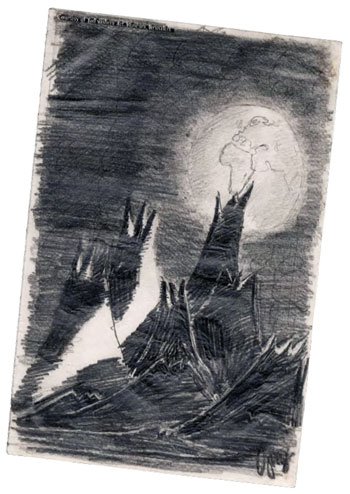 Moon Landscape, 1942-1944, Petr Ginz; pencil on paper;
collection of the Yad Vashem Art Museum, Jerusalem; gift of
Otto Ginz, Haifa.
Moon Landscape, 1942-1944, Petr Ginz; pencil on paper;
collection of the Yad Vashem Art Museum, Jerusalem; gift of
Otto Ginz, Haifa.Nazi regulations stipulated that "mixed-breed" Jewish children should be transported to camps once they reached 14 years of age. Petr was sent to Terezin (also called Theresienstadt), an 18th-century walled fortress about 40 miles north of Prague. In 1942, as part of Hitler's "Final Solution" to exterminate all Jews, the Nazis turned the town into a ghetto for Jewish prisoners.
Terezin would eventually hold more than 140,000 Jews on their way to extermination camps farther east. Until the fortress was liberated by Soviet troops in May 1945, some 35,000 prisoners died there. Of the 15,000 children who passed through the fortress' gates, only about 150 emerged alive. Terezin was bleak and overcrowded, with an estimated 58,000 Jews at one time forced into barracks built to accommodate 7,000 troops. They suffered terribly from stress, lack of food, and unhygienic living conditions that fostered and spread disease. Ironically, the Nazis used Terezin to convince the International Red Cross that they treated captives well. During a June 1944 inspection, they took Red Cross officials to carefully groomed parts of the town where adults enjoyed good meals and sweet coffee in cafés while children romped in playgrounds.
Petr depicted the stark reality in an article he wrote for Vedem ("We Lead"), the underground magazine he edited at Terezin. After a visit to the abysmal quarters for older prisoners, he recalled "the stinking ... stench of latrines, weak light, [and] filth, physical and spiritual."
Yet, Terezin housed many Jewish artists, writers, and intellectuals, who provided lectures in secret to continue the education of the camp's children. Tapping a library of books confiscated from Jews by the Nazis, Petr learned history, geology, sociology, math, and science. He read Charles Dickens, Thomas Mann, and Honoré de Balzac, and he studied the works of Rembrandt and medieval Czech theater. He drew maps, painted, and practiced a cryptic code of his own invention.
In 1944, Eva joined Petr at Terezin. She found that her dreamy, naïve brother had changed into a serious young man, one admired by other prisoners. "A girl...said he was the most intelligent boy [there]," Eva wrote in her own diary. "I was...very proud of him."
Even within Terezin's walls, Petr's craving for knowledge and discovery endured. As Eva later wrote in the foreword to his published diaries, "From all his activities in [Terezin], it is clear that he believed he would return to the world from which he had been torn, and that he expected to fulfill a certain task in it, a mission for which he had to prepare. He believed that the world was waiting for his contribution."
To fill the days and months, Petr wrote novels, including the tale of Ka-Du, short stories, poems, and articles for Vedem. In one article, he proclaimed: "They tore us unjustly from the fertile ground of work, joy, and culture, which was supposed to nourish our youth. They do this...to destroy us not physically, but spiritually and morally. Will they succeed? Never! Deprived of our former sources of culture, we shall create new ones. Separated from the sources of our old happiness, we shall create a new and joyfully radiant life!"
Eva cannot erase Sept. 28, 1944, from her memory. Gathered with other prisoners at Terezin, she watches as families say their goodbyes. "It was a terrible sight; I will not forget it till I die," she writes in her diary. "A throng of women, children, and old people were pushing near the barracks to get a last glimpse of their son, husband, father, or brother. The men were leaning out the windows, pushing and shoving one on top of the other, to glance their dearest.... Crying was heard from everywhere."
Somehow, Eva manages to push her way to the front of the crowd to see Petr and their cousin, Pavel. Desperately, she pushes two slices of bread through the bars of the window and into Petr's hands. Before the ghetto cop chases her away, brother and sister briefly clasp fingers.
After a nightmare journey in a cramped and crowded goods car, Petr arrived in Poland—at Auschwitz. When he stumbled off the train, Petr's fate hung in the balance. The guards might put him in the group of men and boys to work in slave labor camps. Or, he'd join the old and the sick, the women and children at the large building that loomed in the background, a steady stream of smoke pouring from its chimney.
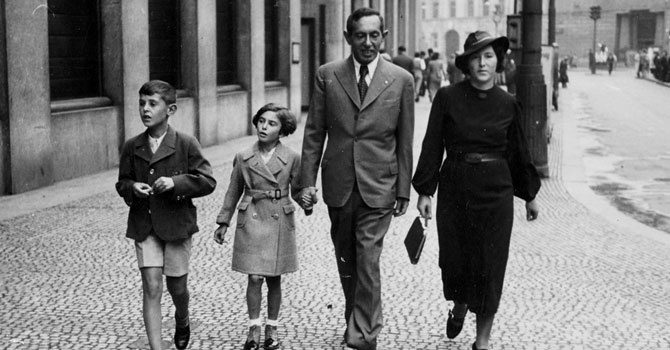 Photo: Private Collection of Chava Pressburger
In 1938, Petr and Eva Ginz stroll with their parents through Prague. "Our parents
raised Petr and me to have good manners, discipline, and education," wrote Eva.
"They taught us to distinguish between right and wrong, good and bad." Soon,
this happy family would become victims of the evil of the Holocaust.
Photo: Private Collection of Chava Pressburger
In 1938, Petr and Eva Ginz stroll with their parents through Prague. "Our parents
raised Petr and me to have good manners, discipline, and education," wrote Eva.
"They taught us to distinguish between right and wrong, good and bad." Soon,
this happy family would become victims of the evil of the Holocaust.Under the Nazis' coldly efficient system of mass slaughter, several trains a day for more than two years arrived at Auschwitz, disgorging their loads of terrified humanity. The prisoners were mainly Jews but also gypsies, captured Soviet fighters, and other victims of Hitler's insane hate, and they arrived from all over German-occupied Europe at this network of concentration and extermination camps. Some Jews committed suicide on the trains, while others died from illness or starvation. When the survivors arrived at the camp, guards sent some 90 percent immediately to the gas chambers.
Soviet soldiers liberated Auschwitz on Jan. 27, 1945, too late for the estimated 1.3 million people who died there. They discovered several thousand sick and dying prisoners—along with mountains of heaped clothes, shoes, and other personal belongings taken from captives. In one warehouse, they stumbled upon some 14,000 pounds of human hair, shaved from prisoners for a manufacturer to turn into cloth.
Before the Red Army's arrival, the Nazis destroyed some gas chambers and crematoriums in an attempt to hide evidence of their atrocities. They also killed thousands of prisoners and forced another 60,000 to march to a camp 35 miles away, where trains would take them to areas still under German control. Weak from their ordeal in the camps, about a quarter of the prisoners died in the subzero temperatures of the "death march." When sick or weak stragglers fell behind, German guards shot them and left their bodies in the snow.
As the war ends, concentration camp survivors return to their families. Many sprawl weakly on the floor of the trains, their wasted bodies covered in rags. They look barely alive, as if they've clawed their way out of the grave. Eva scans the pitiful group, hoping to see a beloved face. Now back in Prague with her parents, she's kept her Terezin diary and pledged to save the last entry for the day Petr comes home. The months turn into years, and still Eva waits.
Petr Ginz died at Auschwitz—one of six million Jews, including 1.5 million children, murdered during the Holocaust. Of the Jewish members of the Ginz family, only Eva, her parents, and one cousin survived—to find their lives changed irrevocably. After the war, Petr and Eva's mother, Marie, a gifted vocalist, never again lifted her beautiful voice in song.
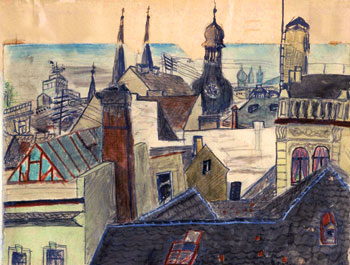 Illustration: Petr Ginz, Rooftops and Towers of Prague, 1939-40 (?), Watercolor and India Ink, Gift of Otto Ginz, Haifa, Collection of Yad Vashem Art Museum, Jerusalem
The teenaged Petr Ginz painted this image of
his beloved Prague while imprisoned in Terezin
concentration camp.
Illustration: Petr Ginz, Rooftops and Towers of Prague, 1939-40 (?), Watercolor and India Ink, Gift of Otto Ginz, Haifa, Collection of Yad Vashem Art Museum, Jerusalem
The teenaged Petr Ginz painted this image of
his beloved Prague while imprisoned in Terezin
concentration camp.The loss of her only son was even harder to bear following witness testimonials at the Nuremberg war crime trials, which provided horrific details about the gas chambers at death camps like Auschwitz. There, crying, shivering prisoners were forced to strip naked and herded into hermetically sealed rooms. Terrified screams of women and children filled the air as the gas fumes spread, while stronger prisoners trampled their comrades in a futile attempt to snatch a last few gasps of oxygen.
Eva now lives in Israel under the name Chava Pressburger. Almost seven decades after the war, she still has nightmares about her brother's final moments. She doesn't know exactly when or how he died, and his final resting place—presumably in an unmarked mass grave—also remains a mystery.
"The picture of this horrific scene [from the gas chambers] often haunts my thoughts, especially at night, even though I try to resist it," Chava writes in the published edition of Petr's diary. "I see Petr in this terrifying situation and I find it hard to breathe.... I ask myself: why him, and not me?"
Despite its dark subject matter, filmmaker Churchill Roberts calls The Last Flight of Petr Ginz a love story. "It's about the love of Eva for her brother," he explains. "And it celebrates Petr's life as much as it bears witness to his untimely and unjust death."
Towards the film's conclusion, Chava is seen driving through Israel's Negev Desert to Tel-Aviv University's Wise Observatory. There, she's greeted by a handsome, young, dark-haired scientist—the kind of man Petr might have grown up to become. He opens a laptop computer and shows her the location of asteroid 50413 Petrginz, discovered in 2000 by two Czech astronomers and named after the young Holocaust victim. Gently, he says, "It will survive there for billions of years."
Undimmed by time or distance or human suffering, Petr's light burns brightly. "The seed of a creative idea does not die in mud and scum," he wrote while in Terezin concentration camp. "Even there it will germinate and spread its blossom like a star shining in darkness."
The little red rocket soars into sight, dwarfed by the glory of giant nebulas and sparkling galaxies. Dodging a stream of deadly asteroids, it bursts through the darkness and swoops joyfully around the rings of Jupiter. Embraced by the radiance of the universe, the adventurer takes flight.

